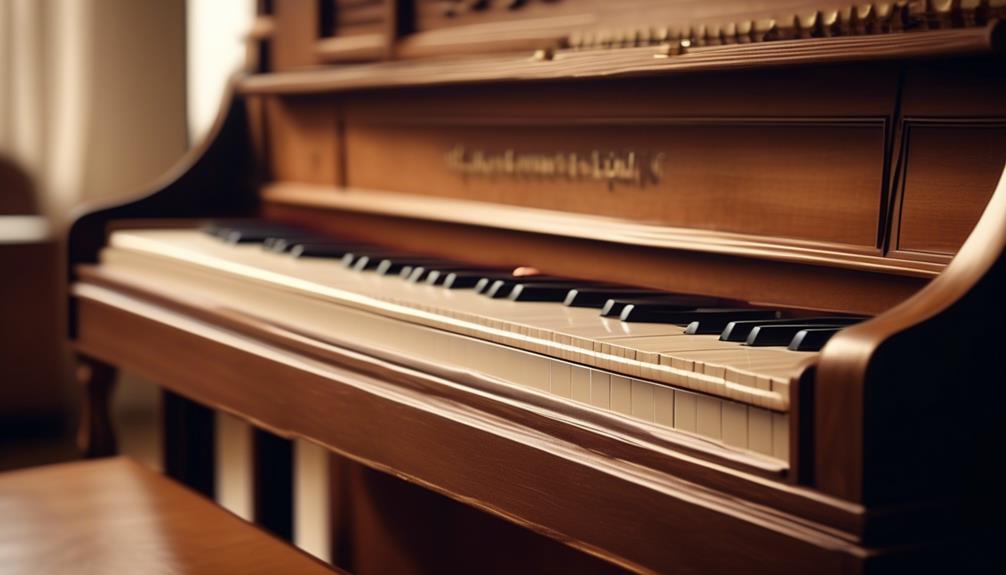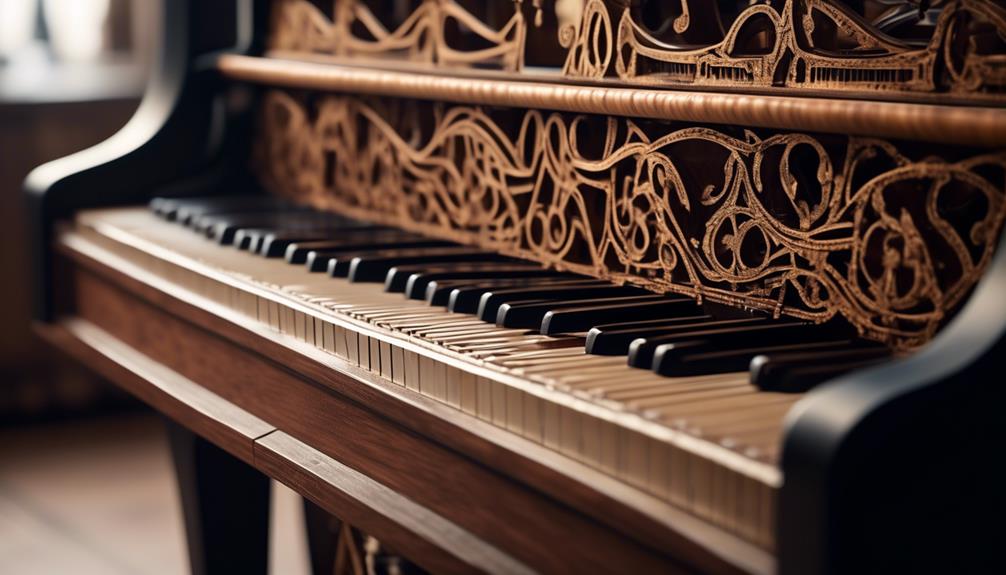The weight of an upright piano is a topic that often piques the curiosity of those who are either considering purchasing one or need to move it to a new location. As a writer who values professionalism and avoids unnecessary enthusiasm, it is important to approach this subject with a level-headed approach. However, the weight of an upright piano is not a simple matter to address, as it is influenced by various factors. From the materials used in its construction to its size and additional features, each element contributes to the overall weight of this musical instrument. In this discussion, we will explore the average weight of an upright piano, the factors that affect its weight, and provide essential tips for safely transporting this majestic instrument. So, let's embark on this informative journey together and uncover the secrets behind the weight of an upright piano.
Key Takeaways
- The average weight of an upright piano ranges from 400 to 900 pounds.
- Larger upright pianos tend to be heavier than smaller ones.
- Pianos made from high-quality hardwoods are heavier than those made from less dense materials.
- The weight of an upright piano can be influenced by factors such as material composition, design and construction, size, and additional features.
Average Weight of an Upright Piano

The average weight of an upright piano, including the case and all components, typically ranges from 400 to 900 pounds. However, there are several factors that can influence the weight of an upright piano. One of the primary factors is the size of the instrument. Generally, larger upright pianos tend to be heavier than smaller ones. This is because larger pianos require more materials for construction, resulting in increased weight. Another factor that affects the weight of an upright piano is the quality and type of materials used. Pianos made from high-quality hardwoods, such as mahogany or walnut, tend to be heavier than those made from less dense materials. Additionally, the presence of extra features, such as ornate carvings or additional soundboard braces, can also contribute to the overall weight of the piano.
When measuring the weight of an upright piano, it is essential to use the correct method to ensure accuracy. The most common method is to use a digital or mechanical scale specifically designed for weighing heavy objects. The piano should be placed on a flat, level surface to obtain an accurate measurement. It is crucial to take into account the weight of any additional components, such as the piano bench or pedals, when calculating the total weight. Additionally, it is advisable to have assistance when measuring the weight of an upright piano to ensure safety and prevent any damage to the instrument or injury to oneself. By considering these factors and using the appropriate weighing method, one can determine the average weight of an upright piano with precision and accuracy.
Factors That Affect the Weight of an Upright Piano
When considering the weight of an upright piano, there are several factors that come into play. First and foremost, the material composition of the piano affects its weight. Pianos made from denser materials, such as hardwood, will be heavier than those made from lighter materials, such as plywood. Additionally, the design and construction of the piano can have a significant impact on its weight, with features such as reinforced frames and additional internal components adding to its overall mass.
Material Composition
The material composition of an upright piano plays a crucial role in determining its weight. Upright pianos are commonly constructed using either wood or metal, with each material having its own impact on the piano's weight and sound quality. Wood is the traditional choice for piano construction, known for its resonance and warm tone. However, it is also heavier than metal, which can make the piano more challenging to move or transport. On the other hand, metal construction offers a lighter weight option, making it easier to handle and transport. However, metal pianos may have a different sound quality compared to wooden ones, with a brighter and sharper tone. Ultimately, the choice of material composition depends on the desired sound quality, portability, and individual preferences of the pianist or owner.
Design and Construction
Design and construction play a pivotal role in determining the weight of an upright piano. The piano manufacturing process involves careful consideration of the materials and techniques used to create the instrument's structure. The design of an upright piano typically includes a solid wooden frame, soundboard, and various interior components. These components, such as the cast iron plate, strings, and hammers, contribute significantly to the overall weight of the piano. The frame provides stability and support, while the soundboard amplifies the vibrations produced by the strings. The interior components, including the action mechanism, keys, and pedals, are meticulously crafted to ensure optimal functionality and sound quality. The attention to detail in the design and construction of an upright piano is essential to produce an instrument that is durable, resonant, and capable of producing beautiful music.
Common Materials Used in the Construction of Upright Pianos

A variety of carefully selected and meticulously crafted materials are utilized in the construction of upright pianos to ensure their optimal performance and enduring quality. The choice of materials has a significant impact on the overall design and functionality of the instrument.
One of the key materials used in the construction of upright pianos is wood. The soundboard, which is responsible for amplifying the vibrations of the strings, is typically made from spruce, a strong and resonant wood. The back of the piano is often made from hardwood such as maple or beech to provide stability and support to the instrument. The frame, or "harp," is commonly constructed from cast iron, which helps to maintain the tension of the strings and prevents warping.
The keys of an upright piano are typically made from wood, often maple or basswood. These materials are chosen for their durability and ability to withstand the repetitive pressure of playing. The hammers, which strike the strings to produce sound, are made from felt or wool. The type and quality of felt used can greatly impact the tone and responsiveness of the piano.
In addition to wood and felt, other materials such as steel wire, brass pins, and copper strings are used in the construction of upright pianos. These materials are selected for their strength, flexibility, and ability to produce clear and resonant tones.
How the Size of an Upright Piano Impacts Its Weight
The size of an upright piano has a direct correlation with its weight. Generally, the larger the piano, the heavier it will be. This is due to the increased amount of materials used in the construction, such as the soundboard, frame, and strings. Additionally, factors such as the type of wood used and the thickness of the piano's components also contribute to its overall weight.
Size and Weight Correlation
When considering the weight of an upright piano, it is essential to understand the direct correlation between its size and overall mass. The size of an upright piano has a significant impact on its weight. Generally, larger pianos tend to weigh more than smaller ones. This is because the size of the piano directly affects the amount of materials used in its construction. Larger pianos require more substantial frames, soundboards, and strings, which add to their overall weight. On average, an upright piano can weigh anywhere between 300 to 800 pounds, depending on its size. It is important to note that while size impacts weight, other factors such as the type of wood used, additional features, and manufacturing techniques can also influence the final weight of an upright piano.
Factors Affecting Piano Weight
The size of an upright piano plays a crucial role in determining its overall weight due to the direct correlation between the two factors. As the size of the piano increases, so does its weight. This is primarily due to the larger dimensions and increased material used in the construction of larger pianos. The table below illustrates the piano weight variations based on different sizes:
| Size (Height) | Weight (Approximate) |
|---|---|
| 42 inches | 400-500 pounds |
| 48 inches | 500-600 pounds |
| 52 inches | 600-700 pounds |
| 58 inches | 700-800 pounds |
Apart from size, the internal components of an upright piano also impact its weight. These components include the cast iron plate, soundboard, and strings. The quality and thickness of these parts can vary, affecting the overall weight of the instrument. It is important to consider these factors when determining the appropriate weight for transportation or placement of an upright piano.
Additional Features That Can Increase the Weight of an Upright Piano

Certain additional features incorporated into the design of an upright piano can result in an increase in its overall weight. These features are often included to enhance the sound quality and performance of the instrument. One such feature is the addition of extra strings. Upright pianos typically have one or two strings per note, but some models may have three or even four strings per note. The additional strings increase the resonance and volume of the sound produced, but also add to the weight of the piano.
Another feature that can contribute to the weight increase is the inclusion of a larger soundboard. The soundboard is a wooden panel that amplifies the vibrations of the strings, producing a richer and more vibrant sound. However, a larger soundboard requires more materials and adds considerable weight to the piano.
Additionally, the inclusion of a double or triple-walled construction can also contribute to the weight of an upright piano. These walls provide additional support and stability, reducing the risk of warping or damage to the instrument over time. However, the extra layers of wood or other materials add to the overall weight of the piano.
Furthermore, the use of high-quality materials in the construction of the piano, such as solid hardwood for the frame and keybed, can also add to its weight. These materials are chosen for their durability and ability to withstand the tension exerted by the strings, but they do increase the overall weight of the instrument.
Tips for Safely Moving and Transporting an Upright Piano
To safely move and transport an upright piano, it is essential to follow specific guidelines and employ proper techniques. Moving a piano can be a challenging and delicate task, as pianos are heavy and delicate instruments that require special care. Here are some tips to help you safely move and transport an upright piano:
- Use proper lifting techniques: When lifting a piano, always bend your knees and use your legs, not your back, to lift the instrument. This will help prevent straining your back and ensure a safer lift.
- Use a piano dolly: A piano dolly is a specialized piece of equipment designed to transport pianos. It consists of a sturdy platform with wheels that can support the weight of an upright piano. Using a piano dolly will make it easier to move the piano and reduce the risk of injury.
- Secure the piano: Before moving the piano, make sure to secure the lid and lock it in place. This will prevent any unexpected movements or damage to the keys or strings during transportation.
- Protect the piano: To protect the piano from scratches and damage, cover it with moving blankets or pads. This will provide an extra layer of protection during the move and prevent any accidental bumps or scratches.
Frequently Asked Questions About the Weight of Upright Pianos

Moving on to the frequently asked questions about the weight of upright pianos, it is important to address common concerns and provide accurate information regarding this aspect of piano transportation. There are several factors that can affect the weight of an upright piano, such as the materials used in its construction, the size and dimensions of the instrument, and any additional features or accessories it may have. To help understand these factors better, let's take a look at the table below:
| Factors Affecting Piano Weight | How to Measure the Weight of an Upright Piano |
|---|---|
| Construction materials | Use a weighing scale to measure the piano's weight. Place the scale on a flat and stable surface, then carefully lift and place the piano onto the scale. |
| Size and dimensions | Measure the height, width, and depth of the piano. Multiply the dimensions together, then multiply the result by a factor that represents the average density of pianos, which is around 0.4. This will give you an estimate of the piano's weight. |
| Additional features | Take into account any extra features or accessories that may be attached to the piano, such as a built-in metronome or a piano lamp. These additions can add to the overall weight of the instrument. |
Frequently Asked Questions
Can I Move an Upright Piano by Myself or Do I Need Professional Help?
Moving an upright piano requires careful consideration and expertise. While it is possible to move a piano by yourself, it is highly recommended to seek professional help. Professional piano movers have the necessary equipment, knowledge, and experience to ensure a safe and efficient move. They are skilled in handling the delicate nature of pianos, ensuring no damage is caused during the process. Trusting professionals will give you peace of mind and protect your valuable investment.
Are There Any Lightweight Materials Used in the Construction of Upright Pianos?
In the realm of piano construction, the use of lightweight materials has gained considerable attention. Incorporating lightweight materials in the construction of upright pianos offers numerous benefits. These materials not only contribute to the overall weight reduction of the instrument but also enhance its portability and ease of transportation. Moreover, the utilization of lightweight materials does not compromise the quality and sound production of the piano. Therefore, the integration of such materials has become a prominent trend in modern upright piano manufacturing.
Does the Weight of an Upright Piano Affect Its Sound Quality?
The weight of an upright piano can have an impact on its sound quality and performance. The weight of the instrument affects its stability and resonance, which in turn influences the tone and projection of the sound produced. A heavier piano may have a fuller and richer sound, while a lighter piano may have a more delicate and nuanced tone. Manufacturers carefully consider the weight of the piano during its construction to achieve the desired sound quality and performance characteristics.
Can the Weight of an Upright Piano Cause Damage to the Floor or Structure of a Building?
The weight of an upright piano can potentially cause damage to the floor or structure of a building if not properly managed. To protect the floor, it is recommended to use a piano caster cup or a protective mat underneath the piano's legs. Additionally, it is important to consider the location of the piano, especially in upper-level apartments, as the weight can pose a risk to the structural integrity of the building. Consulting with a professional piano mover or structural engineer is advised to ensure proper placement and avoid any potential damage.
Are There Any Downsides to Purchasing a Heavier Upright Piano in Terms of Portability and Transportation?
When considering the purchase of an upright piano, it is important to take into account the potential downsides of a heavier instrument. Portability concerns and transportation challenges are two key factors to consider. A heavier piano may be more difficult to move and transport, requiring additional manpower or specialized equipment. This can result in increased costs and logistical complications. Therefore, it is advisable to carefully evaluate the practical implications of a heavier upright piano before making a final decision.
Conclusion
In conclusion, the weight of an upright piano can vary depending on various factors such as its size, materials used in construction, and additional features. On average, an upright piano weighs between 300 to 500 kilograms (660 to 1100 pounds). Factors such as the use of heavy materials like iron, the size of the piano, and the inclusion of extra features like a player system can significantly increase its weight. Safely moving and transporting an upright piano requires careful planning and specialized equipment to prevent damage.

